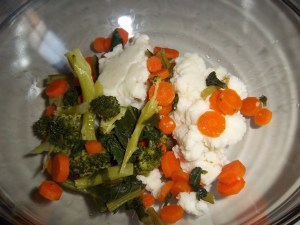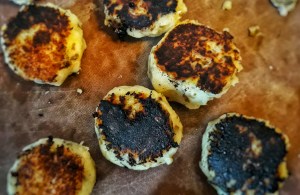Bubble and squeak is one of my favourite left-over foods. It’s difficult to give a recipe for it as you just have to use whatever vegetables you have leftover from a nice roast dinner. It turns out it didn’t begin life as fried mashed potato patties, but as something quite different. In The complete economical cook, and frugal housewife: an entirely new system, Mary Holland – in 1837 – describes a recipe that makes use of leftover boiled beef, not potatoes. The beef should be thinly sliced and fried up with chopped boiled cabbage in butter and some salt and pepper. This recipe goes back as far as the mid-eighteenth century. Indeed recipes for it in this form run right up the mid-twentieth century. It cannot be a coincidence that the dish went from beef-based to potato-based at around the same time as the Second World War and rationing.
Well, here is my recipe for the more familiar – and surprisingly modern – bubble and squeak. It’s hard to give amounts as it is just left-overs:
You have to use some mashed potato as a base and then stir or mash in leftover boiled cabbage, broccoli, carrots or whatever you have. Good additions are kale or dulse that have been crisped up in the oven or frying pan before being crumbled into the spuds
I would say that you should keep the ratio of potatoes to vegetables at least 1:1.Though it is very delicious if all you have left is mashed potato (in my house growing up, we often had fried mashed potato sandwiches with brown sauce!).
If you like, you can stir in an egg; this is especially useful if the potato is dry and difficult to form. Season with salt and pepper.
Get some fat nice and hot in a frying pan. It is extremely important that you use an animal fat such as lard. I like to fry some bacon in the pan first and then use the fat to fry the bubble and squeak in.
You can add your mixture in a single layer or as separate patties. You don’t need any flour to help seal it as it will burn. Instead, add your mix and press it down firmly and then leave it undisturbed for at least 5 minutes. When a nice crust has formed, use a spatula to turn it over. Do this in parts – there’s no way you’ll be able to turn it in one piece.
When both sides have achieved a nice dark-brown crust, it is ready to serve up. I like it with bacon, poached eggs and a good dash of Worcestershire sauce.
The name of the dish comes from the noise it makes in the pan as it cooks – the super-hot and densely-packed vegetables create pressure that’s let out through any gaps. If you didn’t use animal fats, you can’t achieve the high temperatures that give you the bubbles and the squeaks, plus the crust isn’t quite as burnt and satisfying.
If you like, you can fry them one day, and warm them up in the oven a few days later.
If you like the blogs and podcast I produce, please consider treating me to a virtual coffee or pint, or even a £3 monthly subscription: follow this link for more information.





My grandmother was making it in this form as bubble and squeak by the early twenties so it may have been WW1 rather than WW2 that caused the shift from beef to potatoes, but I’ve often wondered if it was the surge in Irish immigrant labour bringing colcannon that fused with the traditional recipe
LikeLike
What a classic British recipe. I’m surprised I’ve not blogged it yet actually!
You might be interested in this from 1807: http://www.archive.org/stream/newsystemofdomes01rund#page/n3/mode/2up
I doubt whether the Irish would have had such an effect on what the general population of Great Britain would have eaten during the period. The time frame doesn’t necessarily fit in either as the Irish population in England and Wales, according to census data, reached it’s peak around 1861 which was a mere 3% of the total population. Not to mention the significant social “othering” that they experienced. However, that is not to say that when necessity arose during the rationing imposed in 1918 potato wasn’t turned to in lieu of beef. However, I’d still say that it probably would have become the widespread norm to use potato during WW2 since rationing was far more stringent. After speaking to my grandparents on the matter of rationing during WW2 it appears to have been extremely hard to get beef in any capacity. Whereas potatoes would have been a great source of vitamins and minerals, particularly when you consider the amount of land necessary to farm cows when compared to potatoes.
LikeLike
Cheers for that information. I am aiming to do some rationing recipes quite soon – perhaps your granparents can leave me some more feedback via you!
LikeLike
Sorry, I meant to say Irish born population.
LikeLike
Ah yes – i hadn’t thought of that. I love colcannon too. Anything involving mash is okay in my book. I shall be adding a colcannon recipe and variants thereon eventually I am sure…
LikeLike
I may make this soon! I love potatoes, and I love greens. Mixing them with some lard or bacon fat means the rest of the family will like them. Colcannon is my favorite. I was actually making it before I even knew it was a recipe. In WWI my German grandmother was eating nettles as a vegetable. I served them to her once in my wild foods phase, and she wasn’t too happy to see them again…
LikeLike
I like nettles as a vegetable. I’ve not spotted any here in the USA as of yet and i assumed they were rather uncommon. Are they easy to find? Nettle soup is good, as is an English cheese called Cornish Yarg that is wrapped in nettle leaves.
LikeLike
I see no-one has mentioned Rumbledethumps ….. The Scots do have their own version of bubble and squeak.
I am a Leeds-girl too and can tell you reliably that bubble and squeak is/was created to use up leftovers from Sunday lunch and traditionally was eaten on a Monday, Monday’s for working class housewife was usually wash day at the wash house and there was little time for cooking elaborate meals on wash day so bubble and squeak was a godsend.
LikeLike
I have never heard of rumbledthumps! I shall do a little research and add a post – thanks for that, Elaine
LikeLike
I have a recipe that has cabbage, potatoes, sausage, and white sauce that I have known as Irish. There is also a song about it. The only lines I remember are “you know I’m a savage, for sausage and cabbage. Some calls it bubble and squeak”. Tried to find the song online to no avail.
LikeLike
Thanks for your comment, Barbara. That’s really interesting; never come across that description of it like that before! What a shame you can’t find the full song!
LikeLike
“Bacon and cabbage” in the original. Recorded by Brendan Shine. Here it is https://www.youtube.com/watch?v=pSXvMlJZ9HA
LikeLike
Pingback: English food - Windsor EducationWindsor Education
Pingback: Ground Beef goes International
Pingback: Would YOU eat that? Guess the unusual British foods from the past! | Austen Authors
Pingback: Would YOU eat that? Guess the unusual British foods from the past! by Sharon Lathan on Austen Authors
Has anyone ever heard of Bubble & Squeek made with left over mashed potato’s, leeks & peas? YUM!
LikeLike
I’m sure it’s been attempted! The potential combinations are infinite though, I suppose!
LikeLike
Pingback: What To Do With Leftover Mashed Potatoes – Daily Meal - Street Dish
Pingback: Dock Pudding | British Food: A History